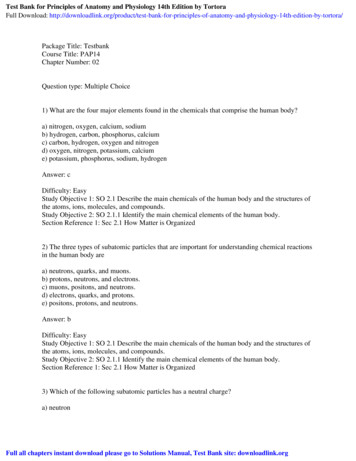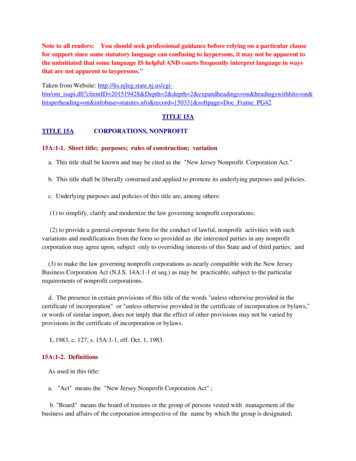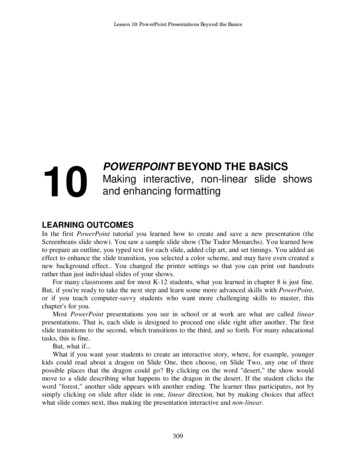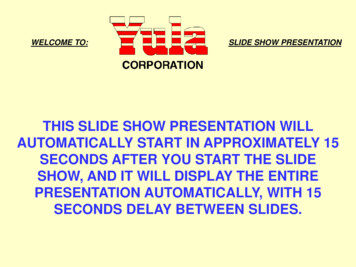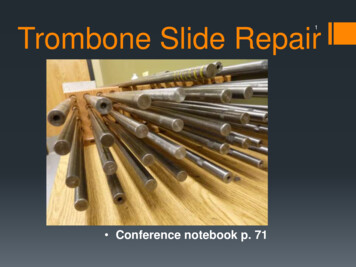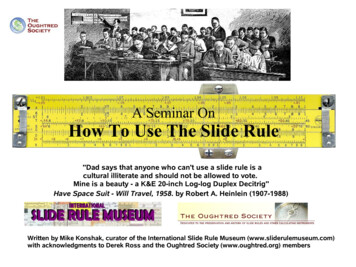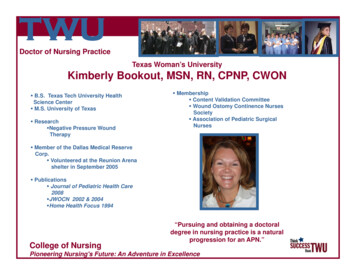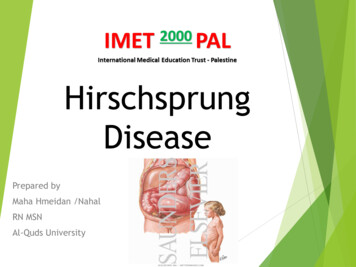
Transcription
HirschsprungDiseasePrepared byMaha Hmeidan /NahalRN MSNAl-Quds University
Hirschprung’s Disease More than 50 years old since the discovery of the causeand the treatment for Hirschprung disease. Incidence : 1 in 5000 live birth 80 % of patients are males
Hirschsprung DiseaseCauses Association with inheritance in chromosome 10 in somepatients. Autosomal Recessive Autosomal dominant in totally agangloinic bowel. Common in Down syndrome
Hirschsprung Disease Aganglionosis is restricted to the rectum and sigmoidcolon in 75% of patients . extends more proximally in 15-20% . and affects the entire colon and a variable length ofileum in 8%. Rarely, ganglion cells are absent from most of thegastrointestinal tract.
Why Hirschsprung Diseasecause constipation This absence of normal parasympathatic innervationprevents gut peristalsis, leading to functionalconstipation. The proximal colon hypertrophied by trying to overcomefunctional obstruction. Transitional zone exists between normal and abnormalaganglionic intestine.
Hirschsprung Disease This results in failure of the internal sphincter to relaxwith rectal distention. Acetylcholine concentrations in aganglionic segmentsare threefold lower than in ganglionic segments.
Clinical Manifestations /diagnosis Only 15% are diagnosed in the first month of life, buttwo thirds are in the first 3 months. Cases beyond 5years of age usually have ultra- short segment disease.
Clinical diagnosisSymptoms within the first week of life include failure to pass meconium within 48 hours,, reluctance to feed ,bilious vomiting, abdominal distention irritability or frowning appearance. Constipation. sometimes Small watery stool Anemia. Delayed Growth. Fever due to infection (enterocolitis)
Clinical diagnosis Explosive liquid stools, fever, and severe prostrationare indicative of enterocolitis. Enterocolitis is rare (10%) in the first month but rises to33% in the second and third months. Recall that diarrhea may be a late sign.
Diagnosis Rectal exam when the rectal vault is found devoid ofstool and the anal canal feels narrow with increasedtone. Abdominal x-ray. Barium enema. Manometry. a test that measures the movement andstrength of the rectal and anal sphincter muscles. Biopsy.
Abdominal X-raymultiple dilated loops of bowel and a low bowelobstruction.
Diagnosis Barium enema - A contrast agent such as barium) isgiven into the rectum in order to coat the inside oforgans so that they will show up on an X-ray. ( narrow segment and dilated proximal portion). Latefilms will show retention of barium at 24- 48 hours.
evidenced on a lateral film from the study.
Anorectal –manometry This determines whether normal reflexes involving therectum and the anus are present. Used only in olderchildren, the test can be performed at the bedside. A small balloon is inflated inside the rectum.
Rectal biopsy is the most reliable diagnostic measure.Absence of ganglion cells in an infant is notconclusive because they may be small andmonopolar.
The acetylcholinesterase stained section illustrates the increase inpositively (darkly) staining fibers within the lamina propria and muscularispropria which, in the absence of ganglion cells, is diagnostic ofHirschsprung disease.
Complicatons of Hirschsprung sdisease include intestinal perforation (particularly at the appendix) Enterocolitis. water intoxication, results from the use of tap waterenemas. there may be hypertonic dehydration from saline enemasmalnutrition, failure to thrive, and anemia.
TreatmentSurgical(Pull-through Surgery) It involves taking out the diseased part of theintestine that doesn't work and connecting thehealthy part that's left to the anus. Aftersurgery, the child will recover well and hisintestines will work normally. Often, the surgery can be done right after thediagnosis.
Colostomy and Ileostomy However, children who have been very sick may first need ostomy to helpthe child to restore his health before having the pull-through surgery. Somedoctors do ostomy in every child before doing the pull-through. In an ostomy, the doctor takes out the diseased part of the intestine, thencuts a small hole called stoma then doctor connects the top part of theintestine to the stoma. Stool leaves the body through the stoma while thebottom part of the intestine heals. Stool goes into the stoma bag that is attached to the skin around the stoma.
Colostomy and Ileostomy If surgery entailed removal of the entire large intestine, the smallintestine are connected to the stoma, the surgery is called an ileostomy. If part of the large intestine is left, then it will be connected to thestoma, the surgery is called a colostomy Later on, the pull-through surgery is performed, the intestines aredisconnected from the stoma and attach just above the anus and thestoma isn't needed any more. In this case either the stoma is sewed upduring surgery or sewed later for about 6 weeks to make sure that thepull-through surgery is working well
Visible transitional zone in mid-sigmoid colon.
Operative photograph showing a sleeve rectal mucosectomy beingperformed down to the anus.
Visible transitional zone
Gross photograph (of another patient) of a distal colonic segmentresected for Hirschsprung disease. Note the dilated, proximal portionseparated from the constricted distal portion by a transition zone.
Post-operative Complications Early Anastomotic leakInfection Late:ObstructionEnterocolitisIncontinence
Hospital care The nurses can teach the family and the child how to care for a stoma andcan talk to you about your worries. After a pull-through surgery, 9 out of 10 children pass stool normally. Some children may have diarrhea for a while, and babies may develop asever diaper rash, eventually the stool will become more solid and the childwill need to go to the bathroom less often. Toilet training may be delayed, as the child learns how to use the bottommuscles only after pull-through surgery. Older children might stain their underwear for a while after the surgery. It isnot their fault. They can't control this problem, but it improves with time.
Diet and Nutrition Drinking plenty of liquids is important after surgery forHD to make sure his body gets enough fluids. An infant who has long-segment disease requiring anileostomy may need special tube feedings to make upfor what is lost. Eating high-fiber foods like cereal and bran muffinscan help reduce constipation and diarrhea.
Infections (enterocolitis). Enterocolitis can be life threatening for a child with Hirschsprung'sdisease, It can happen before or after surgery, so watch for theserious signs and call your doctor immediately if they occur. Serious signs as: fever, swollen abdomen, vomiting and diarrhea, bleeding from therectum, sluggishness and drowsiness In the case of enterocolitis, the child should be admitted to thehospital: In the hospital, an intravenous (I.V.) line may be needed to keepbody fluids up and to deliver antibiotics to fight the infection.
The large intestine will be rinsed regularly with a mildsalt water solution until all remaining stool has beenremoved. The rinse may also contain antibiotics to killbacteria. When the child recovers from infection, then surgery isadvised, and colostomy or ileostomy is done before thechild leaves the hospital.
Having healthy babiesBest wishesMaha Hmeidan
Hirschsprung Disease Aganglionosis is restrictedto the rectum and sigmoid colon in 75% of patients . extends moreproximally in 15-20% . and affects the entire colon and a variablelength of ileum in 8%. Rarely, ganglion cells are absent frommost of the gastrointestinaltract.

